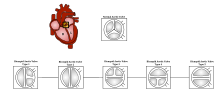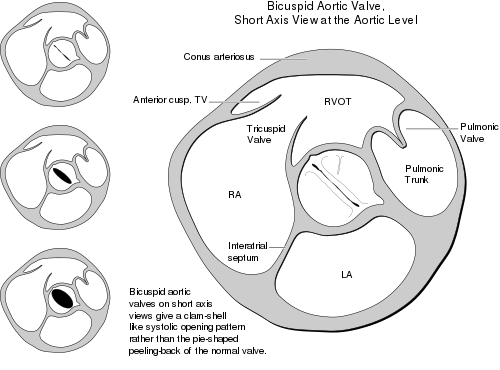Bicuspid aortic valve
| Bicuspid aortic valve | |
|---|---|
| Other names | Bicommissural aortic valve[1] |
 | |
| The aortic valve controls outflow of blood from the left ventricle of the heart through the aorta (valve is indicated within the yellow highlighted box). A normal aortic valve is tricuspid. Five types of bicuspid valve are shown, with Type 1 being most prevalent. A bicuspid valve forms when the tissue surrounding one of the cusps (leaflets) of the valve fuses during fetal development. This developmental anomaly can have either a negative or no effect on the individual. | |
| Specialty | Cardiology |
Bicuspid aortic valve (BAV) is a form of heart disease in which two of the
Signs and symptoms
In many cases, a bicuspid aortic valve will cause no problems.[3] People with BAV may become tired more easily than those with normal valvular function and have difficulty maintaining stamina for cardio-intensive activities due to poor heart performance caused by stress on the aortic wall.[4][5][citation needed]
Complications
Calcification
BAV may become calcified later in life, which may lead to varying degrees of severity of
Aortic lesions
One of the most notable associations with BAV is the tendency for these patients to present with ascending aortic aneurysmal lesions.[8] The extracellular matrix of the aorta in patients with BAV shows marked deviations from that of the normal tricuspid aortic valve, specifically reduced Fibrillin-1. It is currently believed that an increase in the ratio of
Aortic narrowing
A bicuspid aortic valve may cause the heart's aortic valve to narrow (aortic stenosis).[6] This narrowing prevents the valve from opening fully, which reduces or blocks blood flow from the heart to the body. In some cases, the aortic valve does not close tightly, causing blood to leak backward into the left ventricle.[10]
Coarctation of the aorta (a congenital narrowing in the region of the ductus arteriosus) has also been associated with BAV.[11]
Pathophysiology

Fusion of aortic valve leaflets occurs most commonly (≈80%) between the
Hemodynamics
Identifying
BAV outflow is helical and occurs at high velocities (>1 m/s) throughout the ascending aorta.[12][13][14] This is potentially more damaging to the aorta in comparison to the streamline flow and short-lived burst of high velocity at the beginning of the aorta, as seen within a healthy tricuspid valve.[12] This eccentric outflow from the BAV results in blood hitting and reflecting off the aortic wall in a non-streamline fashion.[12][13] The specific zones where blood hits is dependent on the varying BAV leaflet fusion patterns and consequently correlates with increases in WSS.[12][16] WSS measurements in RL fusion indicate an increase in pressure applied predominantly to the right-anterior side of the vessel wall, while RN fusion increases WSS on the right-posterior wall.[12][16] The resulting rise in WSS is supported by the asymmetrical displacement of blood flow produced by an increased angle of outflow from the BAV.[12][13] Displacement is measured as the distance in millimeters from the center of the aorta to the center of the high velocity outflow.[12] Blood does not flow centrally through the aorta in BAV, but along the right-anterior and right-posterior vessel wall for RL and RN leaflet fusion respectively.[12][13]
Aortic disease
Identification of hemodynamics for RL, RN, and left coronary and noncoronary leaflet fusion patterns enables detection of specific aortic regions susceptible to dysfunction and the eventual development of disease.[12][13] Specifically, RL and RN fusion patterns are more likely to develop into these aortic disease states.[12][13] The blood flow information associated with RL fusion causes dilation of the mid-ascending aorta, while RN fusion is associated with dilation in the root, distal ascending aorta and transverse arch.[12][14] BAV helical and high velocity outflow patterns are consistent with aortic dilation hemodynamics seen in those with tricuspid aortic valves.[17] However, it is the increase and variance in WSS and flow displacement in BAV that demonstrate the importance of aortic leaflet morphology.[12] Flow displacement measurements taken from 4D MRI may be best for detecting irregularities in hemodynamics.[12] Displacement measurements were highly sensitive and distinguishable between different valve morphologies.[12] Hemodynamic measurements from 4D MRI in patients with BAV are advantageous in determining the timing and location of repair surgery to the aorta in aortopathy states.[12]
Most patients with bicuspid aortic valve whose valve becomes dysfunctional will need careful follow-up and potentially valve replacement at some point in life. Regular EchoCG and MRI may be performed.[citation needed]If the valve is normally functioning or minimally dysfunctional, average lifespan is similar to that of those without the anomaly.[18]
Diagnosis

A bicuspid aortic valve can be associated with a heart murmur located at the right second intercostal space. Often there will be differences in blood pressures between upper and lower extremities. The diagnosis can be assisted with echocardiography or magnetic resonance imaging (MRI). Four-dimensional magnetic resonance imaging (4D MRI) is a technique that defines blood flow characteristics and patterns throughout the vessels, across valves, and in compartments of the heart.[12][13][19] Four-dimensional imaging enables accurate visualizations of blood flow patterns in a three-dimensional (3D) spatial volume, as well as in a fourth temporal dimension.[12][14][17][19] Current 4D MRI systems produces high-resolution images of blood flow in just a single scan session.[12][19]
Classification
Bicuspid aortic valves may assume three different types of configuration:[20]
- "Real" bicuspid valves with two symmetric leaflets
- A tricuspid architecture with a fusion of two leaflets
- A tricuspid architecture with a fusion of three leaflets
Treatment
Complications stemming from structural heart issues are most often treated through surgical intervention, which could include
Prognosis
BAV frequently leads to significant complications in over one-third of affected individuals which often lead to significant morbidity and mortality.[22] Notable complications of BAV include narrowing of the aortic valve opening, backward blood flow at the aortic valve, dilation of the ascending aorta, and infection of the heart valve.[22]
If aortic regurgitation and dilation of the ascending aorta are noted in someone, they should undergo yearly surveillance with transthoracic echocardiograms if the aortic root measures 4.5 centimeters or greater in diameter.[citation needed]
Epidemiology
Bicuspid aortic valves are the most common cardiac valvular anomaly, occurring in 1–2% of the general population. It is twice as common in males as in females.[23]
Bicuspid aortic valve is a heritable condition, with a demonstrated association with mutations in the
Bicuspid aortic valve abnormality is also the most observed cardiac defect in Turner syndrome.[27]
References
- ^ "Bicuspid aortic valve : MedlinePlus Medical Encyclopedia". medlineplus.gov. Retrieved 27 May 2019.
- S2CID 55778596.
- ^ "Atrial Septal Defect". Commonly Asked Questions About Children and Heart Disease. October 29, 2012. Retrieved April 9, 2014.
- ^ a b Maredia A.K., Greenway S.C., Verma S., Fedak P.W.M. Bicuspid aortic valve-associated aortopathy: Update on biomarkers. Curr. Opin. Cardiol.. 2018;33(2):134-139. doi:10.1097/HCO.0000000000000481
- ^ a b Bissell MM, Hess AT, Biasiolli L,etal.Aortic dilation in bicuspid aortic valvedisease: flow pattern is a major contributor and differs with valve fusion type.Circ Cardiovasc Imaging 2013; 6:499 – 507.
- ^ PMID 10618341.
- ^ Losenno KL, Goodman RL, Chu MWA. Bicuspid aortic valve disease andascending aortic aneurysms: gaps in knowledge. Hindawi 2012; 2012:145202 – 145218.
- .
- .
- ^ Aortic valve stenosis (AVS). American Heart Association. http://www.heart.org/HEARTORG/Conditions/CongenitalHeartDefects/AboutCongenitalHeartDefects/Aortic-Valve-Stenosis-AVS_UCM_307020_Article.jsp#.WclzKdjrvcs. Accessed December 23, 2018.
- doi:10.1136/bmj.e956.
- ^ PMID 24345403.
- ^ PMID 23771987.
- ^ PMID 20308444.
- PMID 15489098.
- ^ PMID 19953319.
- ^ PMID 18515137.
- PMID 18506017.
- ^ PMID 12655592.
- OCLC 254078723.[page needed]
- ^ Mohler ER, et al. Management of thoracic aortic aneurysm in adults. https://www.uptodate.com/contents/search. Accessed December 23rd, 2018.
- ^ PMID 24743897.
- PMID 18799444.
- PMID 16025100.
- PMID 15234422.
- ISBN 978-0-7817-3406-6.
- PMC 3786649. Retrieved 13 December 2022.

